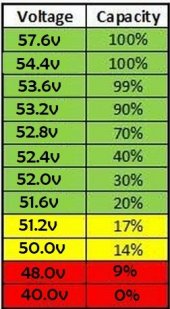Rumbaar
New Member
I've recently gotten a ePever Tracer5420AN charge controller and a 48V Voltx 100ah (SH48-100+LCD) battery, for my solar array (3 x 350W).
The charge controller had 12V @ 25c settings defined in it's manual for Lithium batteries, to which I multiplied by 4 to get the values for 48V system. But then I saw the built in LFP settings and changed to the built in LFP16 settings as below:
ePever LFP16
But the Voltx has these suggested settings in their manual for when charging with a controller and I'm not certain how to translate those to the above settings, and I want to ensure the batteries BMS is avoided over the controllers protection. I can sort of work out the equivalent of the above, but then not sure how changing those has a flow on affect to other settings, and assistance or guide would be very helpful.
The charge controller had 12V @ 25c settings defined in it's manual for Lithium batteries, to which I multiplied by 4 to get the values for 48V system. But then I saw the built in LFP settings and changed to the built in LFP16 settings as below:
ePever LFP16
| Over Voltage Disconnect Voltage | 59.2V |
| Charging Limit Voltage | 58.4V |
| Over Voltage Reconnect Voltage | 58.4V |
| Equalize Charging Voltage | 57.6V |
| Boost Charging Voltage | 57.6V |
| Float Charging Voltage | 53.6V |
| Boost Reconnect Charging Voltage | 52.8V |
| Low Voltage Reconnect Voltage | 52.0V |
| Under Voltage Warning Reconnect Voltage | 51.2V |
| Under Voltage Warning Voltage | 49.6V |
| Low Voltage Disconnect Voltage | 46.4V |
| Discharging Limit Voltage | 44.0V |
But the Voltx has these suggested settings in their manual for when charging with a controller and I'm not certain how to translate those to the above settings, and I want to ensure the batteries BMS is avoided over the controllers protection. I can sort of work out the equivalent of the above, but then not sure how changing those has a flow on affect to other settings, and assistance or guide would be very helpful.
| Overcharge Protection Voltage | 58.4V |
| Overcharge Recovery Voltage | 56.8V |
| Over-discharge Protection Voltage | 40.0V |
| Over-discharge Recovery Voltage | 42.4V |
Last edited:




